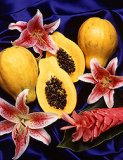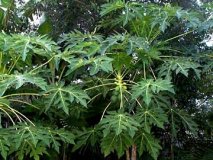Papaya
http://www.100md.com
《e Natural Health Center》
 |
 |
 |
 |
Fruits
Papaya
Latin:
Carica papaya
Origin:
The fruit of a large plant Carica papaya L., belonging to the Caricaceae family, also called papaw, or pawpaw. Though its origin is rather obscure, the papaya may represent the fusion of two or more species of Carica native to Mexico and Central America. Today it is cultivated in both tropical and subtropical regions, including Mexico, Brazil, India, and Southeast Asia.
, 百拇医药
Ripe papayas are not only a treat for the taste buds, they contain papain enzymes that promote digestion. Its palmlike trunk, up to 8 m tall, is not as woody as the designation generally implies. The plant is crowned by deeply lobed leaves, sometimes 60 cm across, borne on hollow petioles 60 cm long.
Normally, the species is dioecious, male and female flowers being produced on separate plants; but hermaphroditic forms are known, and numerous irregularities in the distribution of the sexes are common. Male flowers are borne in clusters on stalks 90 cm long; the flowers are funnel-shaped, about 2.5 mm long, and whitish, and the corolla is five-lobed, with 10 stamens in the throat. The female flowers are considerably larger, on very short stalks, and often solitary in the leaf axils; they have five fleshy petals that are united toward the base and a large cylindrical or globose superior ovary that is crowned by five fan-shaped sessile stigmas.
, 百拇医药
The fruit is commonly spherical to cylindrical in form, is 75 to 500 mm or even more in length, and sometimes weighs as much as 9 to 12 kg. In general character it strongly resembles a muskmelon. The very juicy flesh is deep yellow or orange to salmon-coloured and about 25 mm thick. Along the walls of the large central cavity are attached the numerous round, wrinkled black seeds, the size of peas.
The papaya fruit is slightly sweet, with an agreeable musky tang, which is more pronounced in some varieties and in some climates than in others. It is a popular breakfast fruit in many countries and is also used in salads, pies, sherbets, juices, and confections. The unripe fruit can be cooked like squash.
, http://www.100md.com
There are about 50 varieties of papayas, many of which are inedible and not sold commercially. Some varieties weigh up to 9 kg while others average about 220 g. Most common commercial varieties, such as the Hawaiian Solo, are on the small side. Papayas with reddish flesh have a taste that differs from that of the orange-fleshed types, which are sweeter. The babaco, a natural papaya hybrid from Ecuador, is often canned or made into jam, but is also good eaten fresh.
, http://www.100md.com
Papayas are usually grown from seed. Their development is rapid, fruit being produced before the end of the first year. Under favorable conditions, a plant may live five years or more. Though papaya trees do not live long, they nevertheless seed easily and yield fruit year-round, with the peak season running from April through October.
Also called Green Papaya, Melon Fruit, Melon Pawpaw, Papaw, Paw-paw, Solo Papaya, etc.
Properties:
, 百拇医药
Sweet in flaovr, mild in nature.
Functions:
Disperses blood coagulations, promotes digestion with some bacteriostatic action and also stimulates bowel movements, so it may be tried for dysentery (inflammation of the intestines) and constipation. Besides, there are some reports demonstrating its anti-tumour action.
Applications:
, http://www.100md.com 1. For thirst and chronic coughing:
Use 250-500 g ripe fresh papaya and steam. Eat twice a day.
2. For indigestion and abdominal pain:
Use 500 g green unripe papaya. Remove its peel and seeds and cut into cubes in the size of walnut. Soak in vinegar for 2-3 days. Eat 30 g twice daily.
3. For intestinal parasites:
Use 50 ml vinegar prepared from the above recipe at bedtime.
, http://www.100md.com
4. For boils and carbuncles (skin disease with pus):
Smash 250 g ripe fresh papaya and apply locally.
Dosage and Administration:
Green, or unripe, papayas may be cooked like winter squash. Ripe papayas are terrific eaten plain or with a dollop of yogurt. Simply cut in half and remove the seeds; the flesh is tender enough to be scooped out with a spoon. Although papaya skin is not edible, its seeds are. Papaya seeds resemble large peppercorns and also have a peppery taste. They may be crushed and sprinkled on salads in the same way as crushed peppercorns. Left whole, they make an interesting garnish for a fruit salad. Add papaya to fruit salads or puree into a thick juice.
, http://www.100md.com
If papayas are picked completely green and firm, they will usually not ripen, but can be used in cooking. Choose fruit that is free of black spots and damage to the skin. The spreading yellow color indicates the papaya is softening and shows how far along it is in ripening; fruit with a little yellow near the end takes five to seven days to ripen. Ripe yellow papayas may be stored in the refrigerator for about a week. Refrigeration will also slow the ripening process in fruit intended for cooking.
, 百拇医药
Cautions on Use:
Reference Materials:
Toxic or Side Effects:
Modern Researches:
Papaya contains protein, carbohydrate, fat, fiber, carpaine, papain, cryptoxanthine, rennin, violaxanthin, carrotene and lycopene. It is also an excellent source of vitamin C, and a good source of folate.
, http://www.100md.com
Papain is a protein-digesting enzyme that is contained in the milky juice of the unripe fruit. It greatly resembles the animal enzyme pepsin in its digestive action. This juice is used in the preparation of various remedies for indigestion and in the manufacture of meat tenderizers.
Unripe papayas are particularly good for indigestion and promoting milk secretion. Ripe fruits are particularly good for promoting urination and bowel movements and also for dysentery., 百拇医药